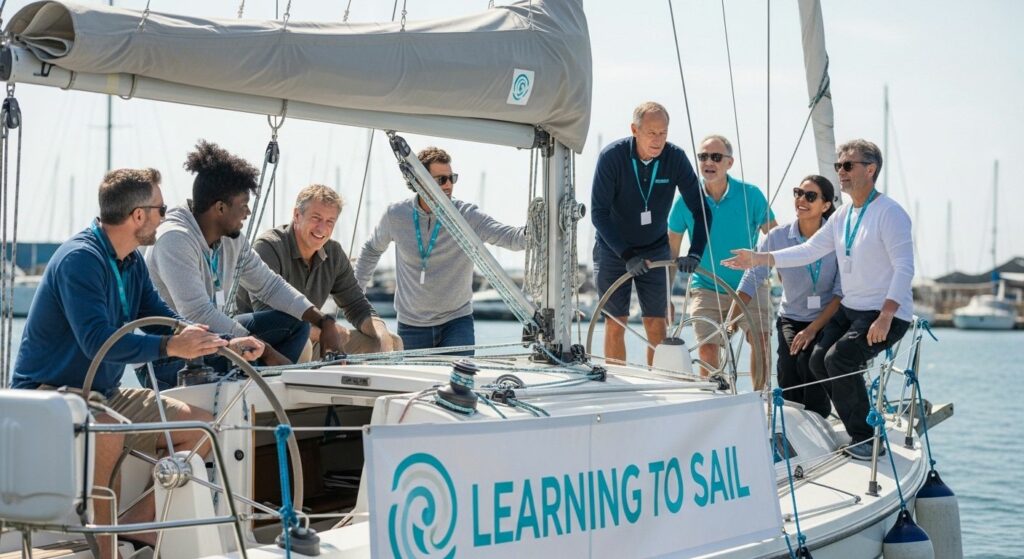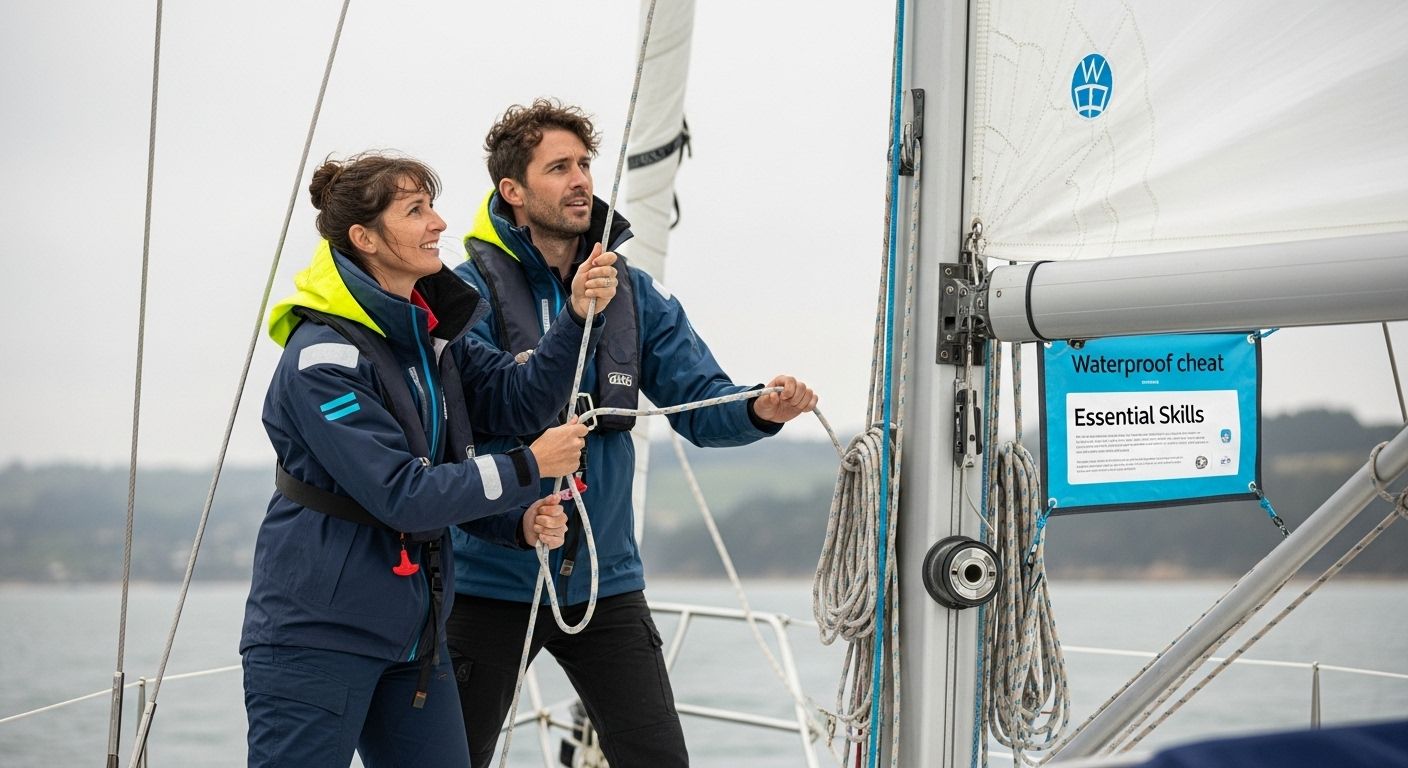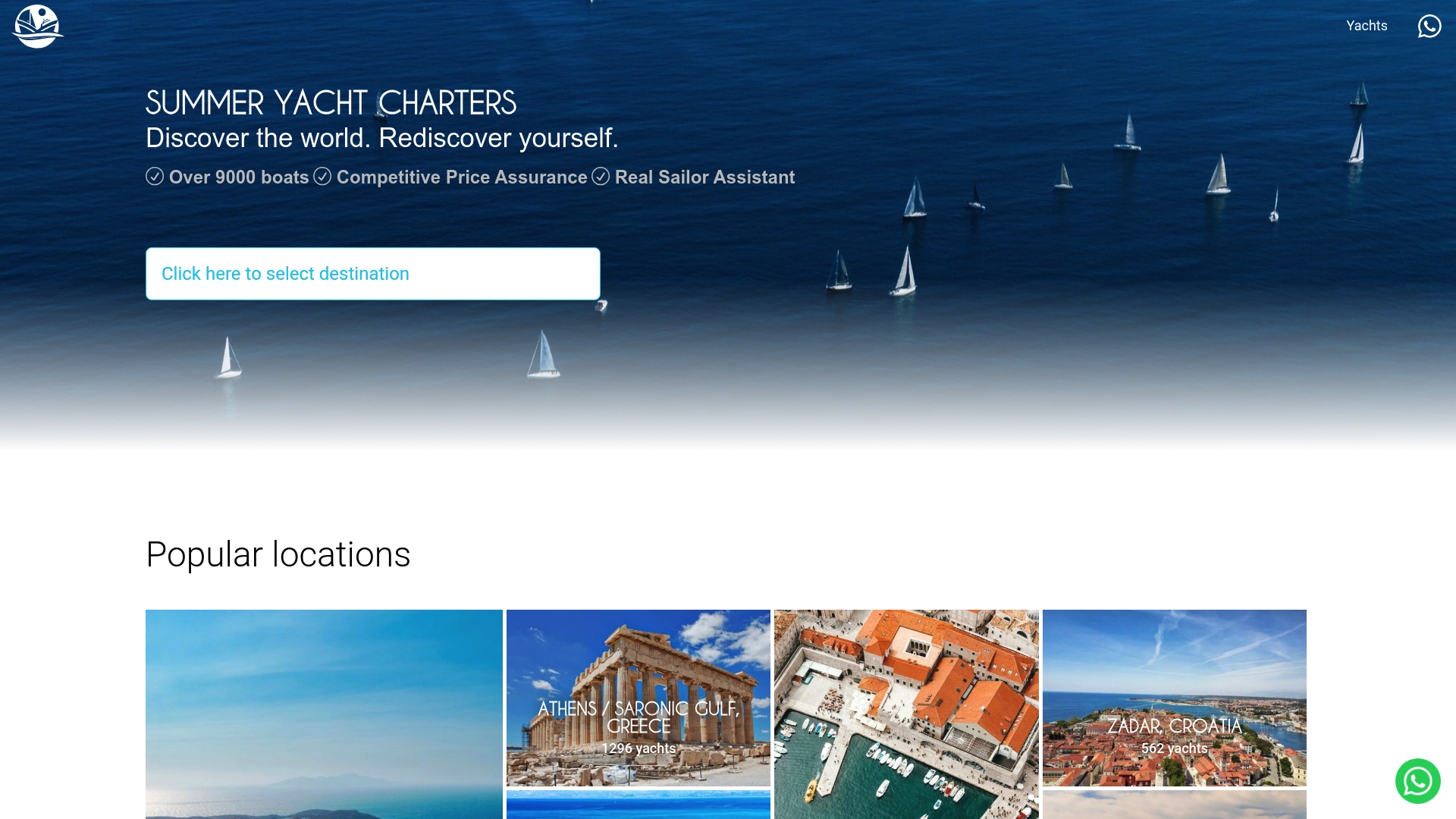Learning to Sail as an Adult: Your Complete Guide
Discover the benefits and best routes for learning to sail as an adult. Tips for all experience levels, including practical skills and essential resources.

Learning to sail as an adult seems like a daunting leap into the unknown. Most people assume it is reserved for those who grew up by the water or started young. Yet the truth is that more adults than ever are taking the plunge and discovering a whole new world at sea. In fact, structured sailing voyages report a striking 90 percent improvement in participant wellbeing and confidence. This means it is never too late to embrace adventure and reshape your sense of self on the water.
Table of Contents
- Why Adults Choose to Learn Sailing
- Essential Skills And Training Options
- Tips For A Successful First Experience
- Joining Sailing Trips And Building Confidence
Quick Summary
| Takeaway | Explanation |
|---|---|
| Sailing fosters personal growth and resilience | The challenge of sailing enhances mental and physical capabilities, promoting self-discovery and mastery of new skills. |
| Join sailing communities for social connections | Engaging in sailing courses or clubs allows adults to form meaningful relationships through shared experiences and learning. |
| Invest in safety and proper equipment | First-time sailors should prioritise high-quality safety gear and appropriate clothing to ensure a secure and enjoyable experience on the water. |
| Embrace structured learning for confidence | Participating in guided sailing trips helps adults gradually build skills and confidence through real-world practice and peer support. |
| Maintain a positive mindset in learning | Approaching challenges with patience and optimism is essential for overcoming obstacles and enjoying the learning process in sailing. |
Why Adults Choose to Learn Sailing
Learning to sail as an adult represents more than just acquiring a new skill. It is a transformative journey of personal growth, adventure, and self-discovery that attracts individuals seeking meaningful experiences beyond traditional recreational activities.
Personal Development and Challenge
Adults are increasingly drawn to sailing as a profound method of challenging themselves mentally and physically. According to research in the Sociology of Sport Journal, sailing offers a unique environment for lifelong learning and personal development. The complexity of navigating a vessel requires strategic thinking, adaptability, and continuous skill refinement. Unlike passive leisure activities, sailing demands active engagement, problem-solving, and quick decision-making in dynamic environments.
The learning curve is steep but immensely rewarding. Adults who embrace sailing discover they are capable of mastering intricate technical skills while developing resilience and confidence. Each nautical mile travelled represents a personal achievement, pushing individuals beyond their perceived limitations and creating a sense of accomplishment that transcends age-related barriers.
Social Connection and Community
Beyond individual growth, sailing provides exceptional opportunities for building meaningful social connections. Many adults find traditional networking and friendship formation challenging in their professional lives. Sailing communities offer an organic, shared-experience environment where individuals bond through mutual learning, collaborative challenges, and a passion for maritime adventure.
Sailing courses, clubs, and recreational groups become natural platforms for meeting like-minded individuals who share similar interests in exploration and personal challenge. These social networks often extend beyond the water, creating lasting friendships rooted in shared experiences and mutual respect for nautical skills.
Health and Wellness Benefits
Physical and mental wellness represent another compelling motivation for adults learning to sail. The activity provides a holistic approach to health that combines cardiovascular exercise, strength training, and stress reduction. Navigating a boat requires constant movement, core engagement, and spatial awareness, offering a full-body workout that feels more like an adventure than traditional exercise.
Moreover, being on the water provides significant psychological benefits. The rhythmic motion of waves, open horizons, and connection with natural environments contribute to reduced stress levels and improved mental clarity. Research indicates that maritime activities can significantly lower cortisol levels and enhance overall emotional well-being.
For adults seeking a meaningful, challenging, and enriching pursuit, sailing offers an unparalleled journey of personal transformation. It is not merely about learning a skill, but about embracing a lifestyle that continuously challenges, inspires, and connects individuals with themselves, others, and the vast, magnificent world of maritime adventure.
Essential Skills and Training Options
Embarking on a sailing journey as an adult requires a strategic approach to skill acquisition and training. Understanding the essential skills and navigating the diverse training options can transform a novice into a confident sailor.
Foundational Sailing Skills
Learning to sail involves mastering a comprehensive set of technical and practical skills. Research from the Royal Yachting Association highlights several critical competencies for new sailors. These include understanding boat handling, sail trimming, navigation techniques, weather interpretation, and marine safety protocols.
Key foundational skills encompass knot tying, understanding wind dynamics, basic meteorological reading, chart navigation, and emergency response procedures. Beginners must develop spatial awareness, learn to read nautical charts, comprehend maritime communication protocols, and understand basic vessel mechanics. These skills form the bedrock of safe and confident sailing.

Training Pathways and Certification
Adult learners have multiple training pathways to choose from, each catering to different learning styles and commitment levels. According to the International Sailing Schools Association, training options typically include:
To help new adult sailors evaluate their training options, the table below organises the key features, advantages, and typical formats of the major sailing training pathways mentioned in the article.
| Training Pathway | Format | Key Features | Typical Advantage |
|---|---|---|---|
| Classroom Courses | In-person classroom | Theoretical knowledge, group setting | Solid understanding of concepts |
| Practical Sailing Workshops | On-water, hands-on | Real-world practice, instructor-led | Skill application |
| Online Learning Modules | Self-paced, digital | Flexible access, modular content | Convenience, foundational info |
| Intensive Residential Programmes | Immersive, mixed | Combined theory and practice, immersive | Rapid skill development |
- Classroom Courses: Structured learning environments providing theoretical knowledge
- Practical Sailing Workshops: Hands-on training with experienced instructors
- Online Learning Modules: Flexible digital courses for foundational understanding
- Intensive Residential Programmes: Immersive training experiences combining theoretical and practical instruction
Professional certifications such as the International Certificate of Competence (ICC) or RYA qualifications provide structured progression and internationally recognized credentials. These certifications validate skill levels and enable sailors to charter vessels in different regions.
Choosing the Right Training Programme
Selecting an appropriate training programme requires careful consideration of individual goals, time availability, and learning preferences. Adult learners should evaluate programmes based on instructor expertise, curriculum comprehensiveness, practical training opportunities, and alignment with personal sailing objectives.
Factors to consider include course duration, cost, class sizes, instructor-to-student ratios, and post-course support. Some programmes offer specialised tracks focusing on specific sailing disciplines like coastal navigation, offshore sailing, or racing techniques. Our guide to yacht charters can provide additional insights into selecting the right sailing training experience.
Successful sailing training goes beyond technical instruction. It involves building confidence, understanding maritime environments, developing risk management skills, and cultivating a profound respect for oceanic conditions. The most effective programmes create holistic learning experiences that transform theoretical knowledge into practical maritime competence.

Tips for a Successful First Experience
Your first sailing experience can be simultaneously exhilarating and challenging. Proper preparation and mindset are crucial for transforming potential anxiety into genuine enjoyment and confidence on the water.
Mental and Physical Preparation
According to US Sailing, successful first-time sailors understand that mental readiness is as important as technical skills. Approaching sailing with an open, patient mindset helps manage unexpected challenges and reduces potential frustration during the learning process.
Physical preparation involves building basic fitness and understanding your body’s limitations. Core strength, balance, and general cardiovascular health contribute significantly to sailing performance. Simple exercises like yoga, swimming, and functional strength training can prepare your body for the dynamic movements required while sailing. Practicing basic stretches and maintaining flexibility will help prevent muscle strain and improve overall comfort on board.
Essential Safety and Equipment Considerations
The Royal National Lifeboat Institution emphasizes the critical importance of safety gear and proper clothing. First-time sailors should invest in high-quality, well-fitting lifejackets, appropriate maritime clothing, and understand basic safety protocols. Layered clothing that can be easily adjusted helps manage changing maritime temperatures and conditions.
Key safety equipment includes:
Below is a table summarising essential safety equipment and recommended items for first-time sailors, as highlighted in the article.
| Equipment Item | Purpose | Recommendation |
|---|---|---|
| Properly fitted lifejacket | Safety in case of falling overboard | Must meet maritime standards |
| Non-slip deck shoes | Prevent slipping on wet surfaces | Comfortable and sturdy |
| Waterproof and windproof layers | Protect against changing maritime weather | Dress in layers, easy to adjust |
| Sun protection (hat, sunglasses) | Prevent sunburn and glare | Use high-SPF sunscreen as well |
| Communication device | Enable contact in case of emergency | Waterproof mobile or marine radio |
- Properly fitted lifejacket: Ensure it meets maritime safety standards
- Non-slip deck shoes: Provide traction and prevent slipping
- Waterproof and windproof outer layers: Protect against maritime weather variations
- Sun protection: Sunglasses, hat, and high-SPF sunscreen
- Communication devices: Waterproof mobile phone or marine radio
Learning and Adaptation Strategies
Successful first-time sailors embrace a learning-oriented approach. US Sailing’s educational programs recommend starting with structured courses that provide comprehensive theoretical and practical training. This approach helps build confidence gradually and provides a supportive learning environment.
Key strategies for a successful first sailing experience include:
- Listen and observe: Pay close attention to instructors and experienced sailors
- Ask questions: Never hesitate to seek clarification or guidance
- Start small: Begin with calm waters and short sailing sessions
- Practice patience: Accept that learning is a gradual process
- Stay positive: Maintain an enthusiastic and resilient attitude
Our comprehensive yacht charter guide can provide additional insights into preparing for your first maritime adventure. Remember, every experienced sailor was once a beginner. Your first experience is about learning, enjoying the process, and developing a lifelong passion for sailing.
Joining Sailing Trips and Building Confidence
Transitioning from classroom learning to real-world sailing experiences represents a critical milestone in an adult sailor’s journey. Joining sailing trips provides an invaluable opportunity to apply theoretical knowledge, develop practical skills, and build genuine maritime confidence.
Understanding Group Sailing Dynamics
Research published in the National Center for Biotechnology Information reveals that sailing environments offer unique opportunities for personal development. Group sailing trips create structured scenarios where individuals learn technical skills while simultaneously developing interpersonal communication and teamwork abilities.
Successful group sailing experiences require understanding collective responsibilities. Each crew member plays a crucial role, whether managing navigation, handling ropes, monitoring weather conditions, or maintaining vessel safety. New sailors must learn to communicate effectively, listen actively, and contribute collaboratively. These interactions build confidence through shared challenges and mutual support.
Structured Learning Through Sailing Voyages
According to UK Sail Training research, participants in structured sailing voyages report remarkable personal growth. Their studies indicate a 90% improvement in participant wellbeing and confidence, with 89% experiencing enhanced communication skills. These structured experiences provide controlled environments where adults can progressively build maritime competence.
Key elements of effective sailing trips include:
- Graduated skill progression: Starting with basic tasks and incrementally increasing complexity
- Expert instructor guidance: Continuous professional support and real-time feedback
- Diverse sailing scenarios: Experiencing various weather conditions and maritime challenges
- Peer learning: Sharing experiences and techniques with fellow sailors
- Reflection and debriefing: Analyzing performance and identifying improvement areas
Confidence-Building Strategies
The National Outdoor Leadership School emphasizes developing seamanship through intentional confidence-building strategies. Adults learning to sail must adopt a growth mindset, viewing challenges as opportunities for learning rather than potential failures.
Effective confidence-building techniques include:
- Incremental skill mastery: Breaking complex skills into manageable components
- Positive self-talk: Maintaining an encouraging internal dialogue
- Celebrating small victories: Acknowledging and appreciating every skill learned
- Embracing vulnerability: Accepting that making mistakes is part of the learning process
Explore more about sailing adventures that can help transform theoretical knowledge into practical maritime expertise. Remember, confidence in sailing is not about perfection but about continuous learning, adaptability, and genuine passion for maritime experiences.
Frequently Asked Questions
What skills do I need to learn to sail as an adult?
To learn sailing as an adult, you’ll need to master foundational skills such as boat handling, sail trimming, navigation techniques, weather interpretation, and marine safety protocols. Additionally, skills like knot tying and understanding wind dynamics are essential.
What are the health benefits of learning to sail as an adult?
Learning to sail offers numerous health benefits, including cardiovascular exercise and stress reduction. The physical activity involved in sailing provides a full-body workout, while being on the water contributes to improved mental clarity and lower stress levels.
How can I prepare for my first sailing experience?
Preparing for your first sailing experience involves both mental and physical preparation. Cultivating an open and patient mindset is crucial, alongside building your fitness through core-strengthening exercises. It’s also important to familiarise yourself with safety equipment and protocols.
What are some effective tips for gaining confidence while learning to sail?
To gain confidence while learning to sail, focus on incremental skill mastery, maintain a positive internal dialogue, celebrate small victories, and accept that making mistakes is part of the learning process. Participating in structured sailing voyages with peer support can also enhance your confidence.
Ready to Take the Helm in the Mediterranean?
The thought of learning to sail as an adult can seem overwhelming. Many people worry they will never catch up to lifelong sailors or struggle to find a welcoming and supportive entry point. The article highlights hurdles such as building confidence from scratch, navigating complex training options, and finding that crucial first real experience out on the water. This journey is about more than new skills—it is about personal challenge, conquering uncertainty, and connecting with a community who understands your goals.
Explore the spirit of adventure in extraordinary places. Our Cyclades destination page introduces you to one of the most sought-after sailing areas in Greece, perfect for putting your new skills into practice amongst breathtaking island scenery.

At Summer Yacht Charters, we remove the guesswork of your first sailing trip. Browse over 11,000 carefully selected yachts and filter by date, vessel, or region in just a few clicks. Whether you want a bareboat challenge or the assurance of a professional crew, our platform makes booking simple and safe. Discover how our tailored itineraries and expert support can turn your first step into a full-circle sailing experience. Book now to unlock confidence on the water and start your transformative voyage today.
Recommended
- What to Wear Sailing: Clothing Guide for Every Sailor – Summer Yacht Charters
- Sailing Holidays for Couples: Discover Romantic Destinations – Summer Yacht Charters
- What Is a Yacht Charter? Essential Guide for 2025 – Summer Yacht Charters
- What Does a Skipper Do? Guide for Sailors & Travellers – Summer Yacht Charters